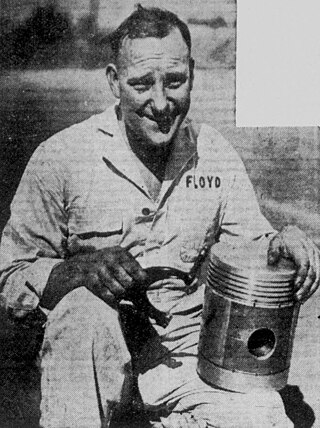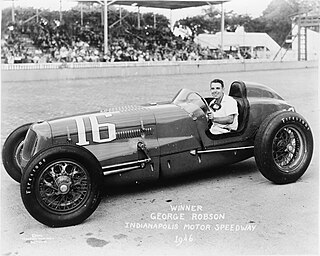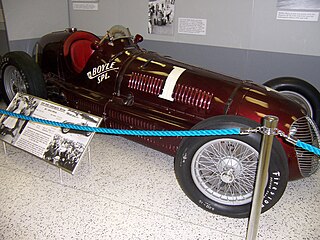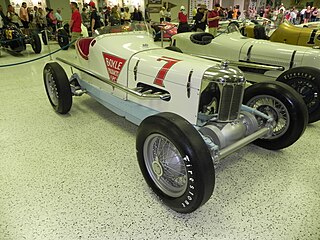
The 39th International 500-Mile Sweepstakes was held at the Indianapolis Motor Speedway on Monday, May 30, 1955. The event was race 1 of 11 of the 1955 AAA National Championship Trail and was race 3 of 7 in the 1955 World Championship of Drivers.

The 43rd International 500-Mile Sweepstakes was held at the Indianapolis Motor Speedway on Saturday, May 30, 1959. The event was part of the 1959 USAC National Championship Trail and was also race 2 of 9 in the 1959 World Championship of Drivers.

William John "Bill" Vukovich was an American racing driver. He won the 1953 and 1954 Indianapolis 500, plus two more American Automobile Association National Championship races, and died while leading the 1955 Indianapolis 500.

Floyd Marion Roberts was an American racing driver. He won the 1938 Indianapolis 500 with a then-record speed of 117.2 mph (188.6 km/h). He led for 92 laps. The following year, 1939, driving the same car, Roberts was killed in a crash. He was the first defending champion of the race to have been killed in competition.
This article discusses the year-by-year history of the Indianapolis 500 race.

The 59th 500 Mile International Sweepstakes was held at the Indianapolis Motor Speedway in Speedway, Indiana on Sunday, May 25, 1975. A. J. Foyt started on the pole position and Bobby Unser won his second Indianapolis 500. Dan Gurney, one of the founders of All American Racers, who finished second as a driver himself in 1968–1969, won his first and only Indy 500 as a car owner. Gurney's Eagle chassis itself scored its third "500" win. The race was part of the 1975 USAC National Championship Trail.

The 29th International 500-Mile Sweepstakes Race was held at the Indianapolis Motor Speedway on Friday, May 30, 1941. The start of the race was delayed due to a fire that swept through the garage area on race morning. No persons were injured, but one car in the field was destroyed. The race rolled off with only 31 cars, and ran to its scheduled distance. This would be the final "500" prior to the United States involvement in WWII. It was not known at the time, but it would be the final race organized by Speedway president Eddie Rickenbacker, and due to the war, the race would not be held again until 1946.

The 30th International 500-Mile Sweepstakes was held at the Indianapolis Motor Speedway on Thursday, May 30, 1946. This was the first Indianapolis 500 presided over by new track owner Tony Hulman. The track had closed in late 1941 due to World War II, and over the next four years, the facility fell into a terrible state of disrepair. Hulman purchased the Speedway in November 1945, and quickly went to work cleaning up the grounds, which had become overwhelmed by overgrowth and weeds. The Speedway re-opened, and the 1946 race was considered a rousing success.

The 7th Liberty 500-Mile Sweepstakes was held at the Indianapolis Motor Speedway on Saturday, May 31, 1919.

The 28th International 500-Mile Sweepstakes Race was held at the Indianapolis Motor Speedway on May 30, 1940. The winner was Wilbur Shaw in the same Maserati 8CTF he had driven to victory in 1939. Shaw became the first driver in the history of the race to win in consecutive years. It also marked Shaw's third win in four years, making him the second three-time winner of the race. Shaw's average speed was 114.277 mph, slowed by rain which caused the last 50 laps to be run under caution. Shaw took home $31,875 in prize winnings, plus additional prizes that included a car and a refrigerator.
The 26th International 500-Mile Sweepstakes Race was held at the Indianapolis Motor Speedway on Monday, May 30, 1938. For 1938, riding mechanics were made optional; however, no teams utilized them in the race. In addition, after seven years, the engine specifications were changed again. The 1930 "Junk" formula was eliminated. Normally aspirated engines were allowed 4.5 liters, and superchargers would be permitted again, with a maximum displacement of 3.0 liters. Any fuel was allowed, which directly affected the race.
The 25th International 500-Mile Sweepstakes was held at the Indianapolis Motor Speedway on Monday, May 31, 1937. With temperatures topping out at 92 °F (33 °C), it is one of the hottest days on record for the Indy 500.
The 24th International 500-Mile Sweepstakes Race was held at the Indianapolis Motor Speedway on Saturday, May 30, 1936. The race was part of the 1936 AAA Championship Car season. The race is remembered for three noteworthy Indy traditions getting their start.
The 23rd International 500-Mile Sweepstakes Race was held at the Indianapolis Motor Speedway on Thursday, May 30, 1935. Despite attempts to improve participant safety by requiring crash helmets and installing green and yellow lights around the track, the event that year would prove to be one of the worst in terms of fatalities.

The 22nd International 500-Mile Sweepstakes Race was held at the Indianapolis Motor Speedway on May 30, 1934. The winner was the number seven car driven by Bill Cummings, an Indianapolis native, at an average speed of 104.863 miles per hour. Cummings led for 57 laps total, including the last 26. Of the 33 cars that began the race, only 12 were running at the finish, although there were no crashes resulting in serious injuries. One serious incident involved George Bailey, whose car went over the outside wall, but resulted in only a broken wrist to the driver. The finish was the closest in the history of the race to that point, with second-place finisher Mauri Rose within 100 yards of Cummings at the finish. Rose would also file a protest that Cummings had illegally gained ground during a "slow-down" period following a crash.
The 21st International 500-Mile Sweepstakes Race was held at the Indianapolis Motor Speedway on Tuesday, May 30, 1933. Louis Meyer defeated Wilbur Shaw by a time of 401.89 seconds. The average speed of the race was 104.162 miles per hour (167.632 km/h) while Bill Cummings achieved the pole position with a speed of 118.521 miles per hour (190.741 km/h). The race was part of the 1933 AAA Championship Car season.

The 20th International 500-Mile Sweepstakes Race was held at the Indianapolis Motor Speedway on Monday, May 30, 1932. Attrition was the story of the race, with 26 of the 40 cars dropping out due to crashes or mechanical failure. A record eight different drivers led laps during the race, with no driver seemingly able to hold the lead without experiencing some sort of trouble. For the third year in a row, Billy Arnold looked as if he would be the dominant car, but he sailed over the turn three wall on lap 59. Rookie Bob Carey also hit the wall while leading. Fred Frame took the lead for good on lap 152, and won from the 27th starting position - the furthest back of any winner except for Ray Harroun in 1911 and later, Louis Meyer in 1936. Frame was accompanied by riding mechanic Jerry Houck.
The 19th International 500-Mile Sweepstakes Race was held at the Indianapolis Motor Speedway on Saturday, May 30, 1931. Race winner Louis Schneider, who led the final 34 laps, was accompanied by riding mechanic Jigger Johnson.
The 18th International 500-Mile Sweepstakes Race was held at the Indianapolis Motor Speedway on Friday, May 30, 1930. The race was part of the 1930 AAA Championship Car season.

The 16th International 500-Mile Sweepstakes Race was held at the Indianapolis Motor Speedway on Wednesday, May 30, 1928. This was the first Indianapolis 500 presided over by new Speedway president Eddie Rickenbacker. Rain threatened to wash out the day, but the showers stopped and the race started on time. One brief shower slowed the race around the 400-mile mark, bringing out the yellow flag for a few laps.












